Persimmons

Mr Raccoon leaves big dirty foot prints on the stairway.
It was the thump overhead that woke us up, followed by violent sounds of thrashing and scraping. From my warm, cozy nest in the bed below it seemed as though an inebriated Santa Claus had just crashed his sleigh into our chimney and now the reindeer were tangled in their harnesses and scrambling for footing on the steep roof. I was befuddled and drowsy but it’s only early November so in my rational mind I knew that the scandal on our roof couldn’t possibly be a consequence of Christmas. “The persimmons must be ripe again,” I decided; “They’re sure an attractive nuisance.” Dissing fruit isn’t a popular stance for a farmer to take, so let me clarify myself by first spelling out what makes persimmons so attractive before I dig into what makes them such a pain.
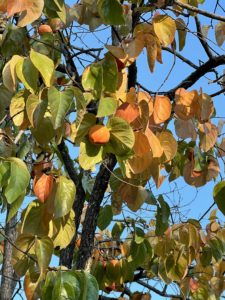
Hachiya Persimmon Tree
Persimmon trees are beautiful, and the rich, deep orange and red hues that their leaves take on in the late fall are as close as we Californians can get to “fall colors.” I remember working on a farm in the Sacramento Valley when I was 20 years old, and one grey, cloudy autumn day we were sent to pick persimmons. There had been a storm the night before and the wind and rain had knocked all leaves to the ground so the fiery, heart-shaped fruit hung from the wet, black branches like jewels- a sight so stunning that I’ve never forgotten it. These were the Hachiya persimmons, the kind that ripen to a slippery, pudding-like goo that is almost obscenely sweet. Another popular persimmon variety is the squat shaped, dusky-orange Fuyu, which has more of an apple-like texture when ripe.
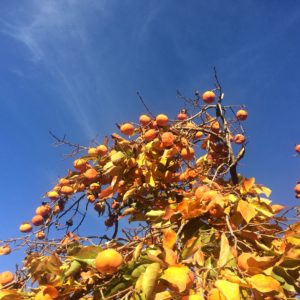
Fuyu Persimmon Tree
When I finally studied up on persimmons I was surprised to learn that the plant is in the same family as the Ebony tree. It takes a persimmon tree a hundred years before it develops the black, tightly grained wood so characteristic of ebony, so it is not a major commercial hardwood but its fruits are appreciated across Southwestern Europe, Asia, and America. Two Japanese persimmon varieties, the Hachiya and the Fuyu, are the most commonly cultivated types available to American shoppers, but interestingly our name for these Asian plants comes from the native American Powhatan word pasiminan, or pessamin. A number of different persimmon species are native to North America, ranging from Connecticut down into Northern Mexico. There are plenty of people who gather and eat the native persimmon types but the American persimmons don’t yet get the shelf space in supermarkets that the Hachiya or Fuyu varieties command.
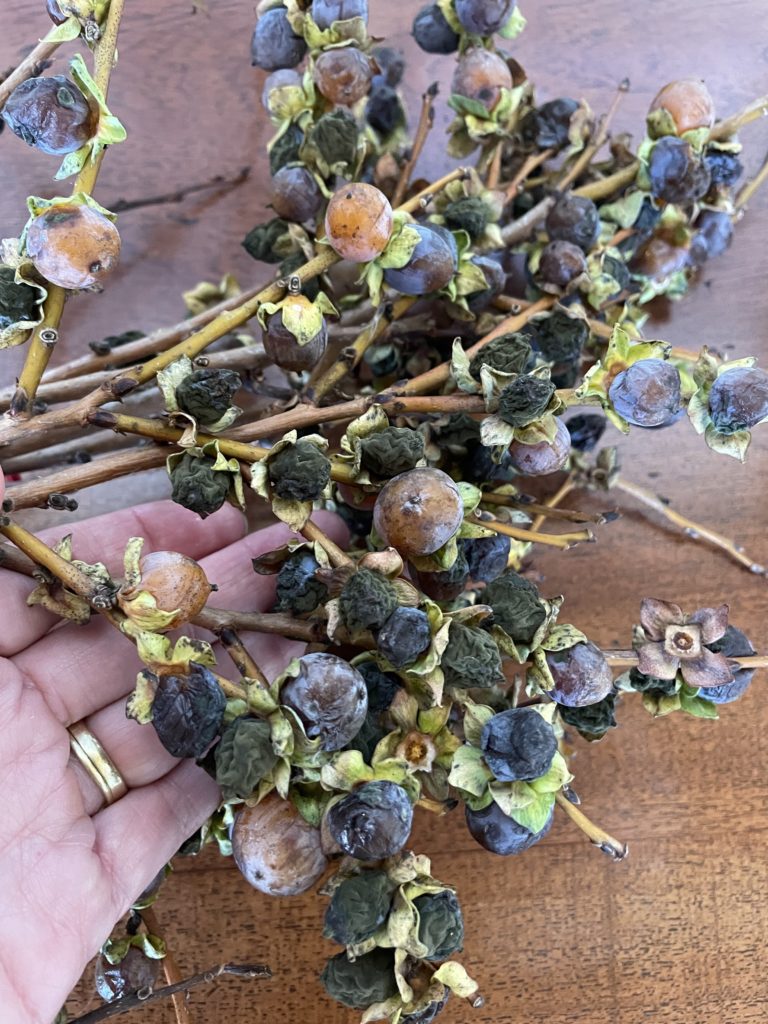
Wild Persimmon are much smaller than the Hachiya and Fuyu varieties. You can eat them off the branch once they’ve turned dark, wrinkled and raisin-like.
Plant scientists have discovered that the germination rate for persimmon seeds goes up dramatically if the whole fruit first passes through the gut of a zoo elephant leading some researchers to speculate that the American species evolved in companionship with the ancient megafauna like the Wooly Mammoth. Now that the Wooly Mammoths can only be found frozen in the tundra or mired in the La Brea tar pits it appears that their taste for persimmons has been taken up by lesser fauna, like the raccoon, which brings me to the nuisance part of this story.
My grandparents planted two persimmons next to our house back in the late fifties, one Hachiya and one Fuyu. These trees frame our home and shade it during the warm months of summer. We live in the country so we share our space with raccoons whether we want to or not. Some mornings we see their muddy footprints on our porch marking where they’d shuffled around, peering through the French doors at us while we were sleeping the night before. But during the fall when the persimmons ripen the coons become overtly obnoxious. Each of our trees have hundreds of fruits hanging from the branches. You’d figure that with all that fruit we’d have enough persimmons for all of the critters and people to enjoy, but that’s not how things work out.
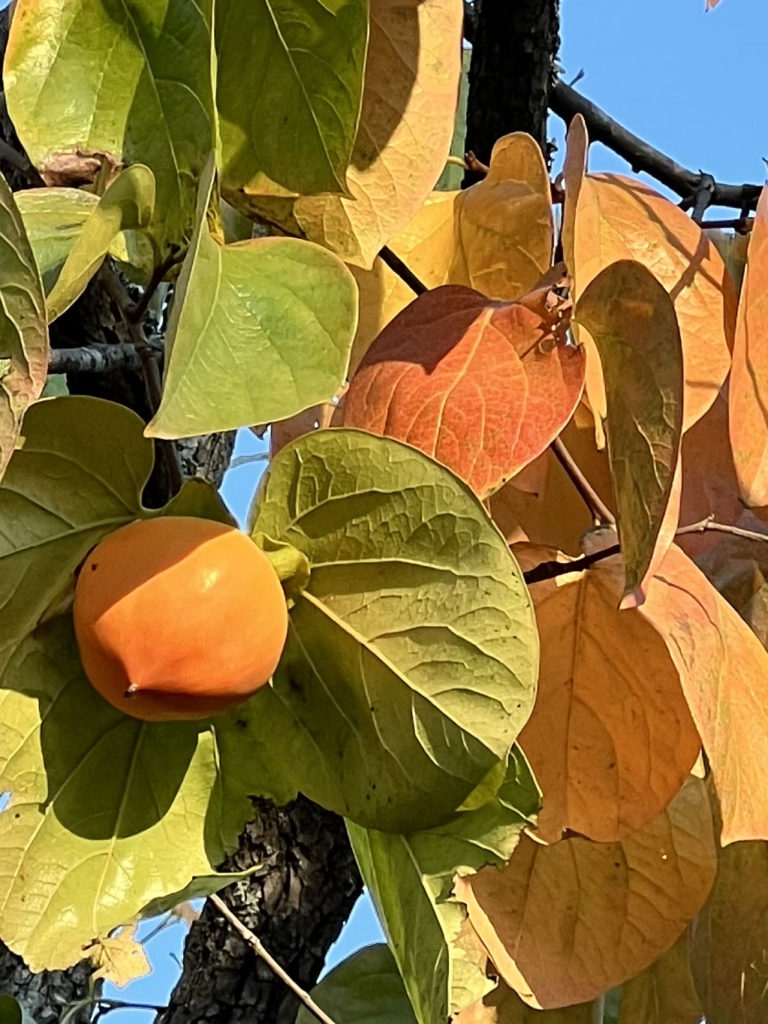 Mr. Raccoon was cute when he was a baby, but now he’s grown up into a big, stinky, brawling thug of a beast with needle sharp teeth. He never went to kindergarten so he never learned to share. He wants to hog ALL of the persimmons just for himself. His numerous cousins and uncles, ex-wives, lovers and children are similarly charm-free and they share his greedy appetite for sugary sweet fruit. As the persimmons begin to color up among the green leaves Mr Raccoon clambers up the tree trunks and strolls across our roof, checking first on the progress of his Hachiya crop and then giving his Fuyu trees a sniff. When he meets another raccoon, similarly bent on eating ALL of the fruit, the two coons snarl out a challenge and the fight is on to see who really owns the crop.
Mr. Raccoon was cute when he was a baby, but now he’s grown up into a big, stinky, brawling thug of a beast with needle sharp teeth. He never went to kindergarten so he never learned to share. He wants to hog ALL of the persimmons just for himself. His numerous cousins and uncles, ex-wives, lovers and children are similarly charm-free and they share his greedy appetite for sugary sweet fruit. As the persimmons begin to color up among the green leaves Mr Raccoon clambers up the tree trunks and strolls across our roof, checking first on the progress of his Hachiya crop and then giving his Fuyu trees a sniff. When he meets another raccoon, similarly bent on eating ALL of the fruit, the two coons snarl out a challenge and the fight is on to see who really owns the crop.
So we get our ladders out and we pick the crop. Otherwise there’s no sleep for us. Luckily, picking persimmons is a nice chore and reaching among the brilliant, orange and red leaves for the beautiful, glossy fruits is not anywhere near as onerous as picking lemons from amidst their thorny branches. And once the harvest is in the fun begins. Yes, if they’re ripe you can eat them out of hand. I especially enjoy eating the fresh Fuyu persimmons as I find the Hachiya almost too sweet. But I never have turned down an opportunity to eat persimmon bread or persimmon cookies. A lot of people enjoy making Hoshigaki, the air-dried persimmons that are such a favorite in Japan. Our friend, Jonathan, has made a tradition out of making hoshigaki. Below are some pictures which illustrate that process. Persimmons have more of a “moment” than a “season” so I hope you enjoy them while they last. And don’t worry about the Raccoon family — they’ve had their turn; now it’s yours.
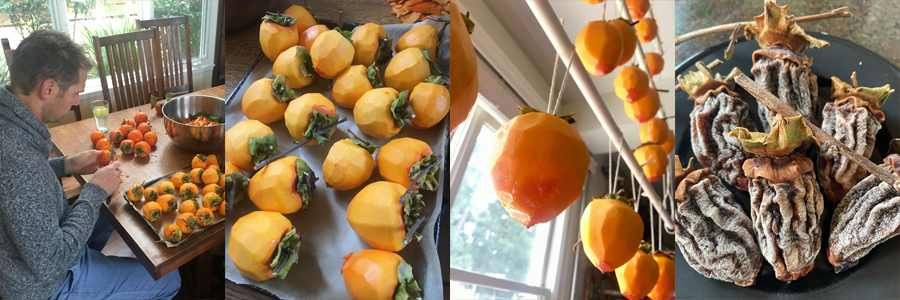
Happy Thanksgiving from all of us at Mariquita Farm!


